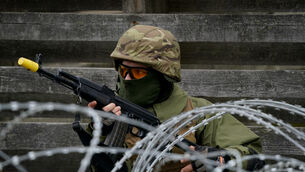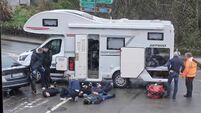Weather threatens more misery for Pakistan quake survivors
Forecasts of rain showers and light snow on earthquake-hit regions of northern Pakistan today threatened to compound the misery of hundreds of thousands of people living in the open with little or no shelter.
Temperatures were expected to dip to about 7 degrees Celsius in the shattered city of Muzaffarabad, the capital of Pakistan-administered Kashmir, and as low as -12 Celsius in the highest mountain villages, the Pakistan Meteorological Department reported.
Snow was expected in villages at about 11,000 feet, the department reported.
With the brutal Himalayan winter just weeks away, the relief effort is rushing to deliver tents, food and medicine to victims before villages are cut-off by snows and helicopter-grounding fog. The UN has warned that thousands more could die without adequate aid.
Pakistan’s official death toll from the October 8 quake stands at 57,597, with 78,800 injured. However, central government figures have lagged behind those of local governments, who put the number of dead at about 80,000.
Another 1,350 people died in Indian-held Kashmir. An estimated 800,000 people still lack any form of shelter.
Unicef said the dead included about 17,000 schoolchildren who had been attending classes when the quake hit. Those who survived will likely suffer lasting trauma from the sudden loss of so many friends, teachers, and other “important people in their lives", the organisation’s executive director Ann Veneman said yesterday.
Pakistan’s government says as many as 8,000 schools were destroyed by the quake.
Doctors working in remote villages say about 20% of patients show signs of the skin infestation scabies – possibly contracted from donated clothing.
Donated clothes “were already dirty when they got here, and it’s a possible cause", said Dr Khalid Zurmati from neighbouring Afghanistan. Scabies is caused by tiny mites.
So many used clothes have been shipped to the area that earthquake victims have in some cases burned them for fuel or used them to dress their livestock against the cold. Authorities have asked people to donate food and medicine instead of clothing.
Quake survivors said they were dubious about Pakistani President Gen. Pervez Musharraf’s pledge to deliver a half-million tents to quake survivors by the end of November.
“The government has no chance of getting us the tents before winter,” said Hafiz Ur-Rahman, aged 55, who was living under a tarpaulin propped up by debris on the outskirts of Muzaffarabad with five family members.
“Everything that is being done on a large scale is being done by foreigners and non-governmental organisations. The government can help, but they’re not doing so good,” he said.
With international aid key, UN Secretary-General Kofi Annan is among those expected to attend a donors’ conference on reconstruction on November 19 in Islamabad.
Pakistan’s military was setting up relief camps and a field hospital for quake victims along its disputed Kashmiri border with India. That followed a weekend agreement with rival India to open their heavily guarded frontier to speed the relief effort.
India has already set up three relief camps on its side of the border.
Relief groups and quake survivors have praised Sunday’s unprecedented border deal, which allows relief goods to be sent in either direction and handed to local authorities at the crossings beginning on Monday. Only Kashmiri civilians with families divided by the border will be allowed to cross on foot.
Nato medical and engineering teams that arrived over the weekend were beginning to deploy, with Polish officers accompanied by Pakistani escorts surveying damage to roads today.














